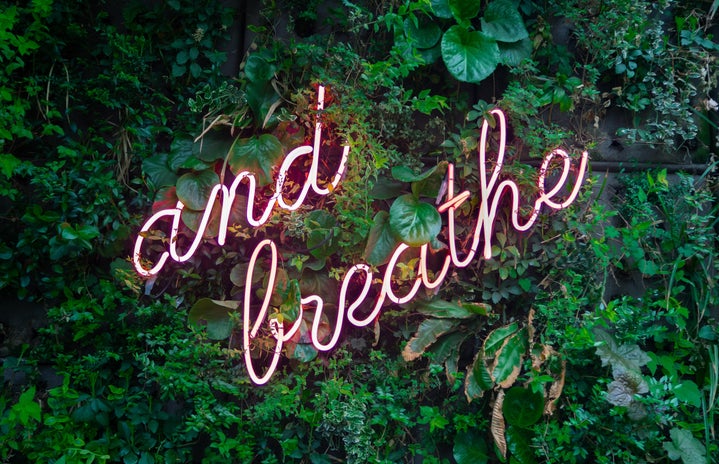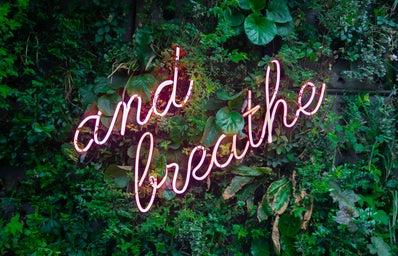With the return to in-person classes, the heightened state of the pandemic or the common stresses of everyday life, it’s completely normal to feel a little anxious. Anxiety is not necessarily a bad thingーit’s your body’s personal security guards protecting and warning you when they believe something might be wrong. That being said, the feeling can become overwhelming and consume us to a point where it’s hard to concentrate on the present. For this reason, I’ve always found it best to focus on the way I breathe.
Breathing exercises are one of the most powerful tools you have and can ground you back into the present moment as well as relax your heart rate, untense your body and clear your mind. Although breathing techniques are often taken for granted, you can turn to them whenever and wherever you are: a small 5 minute break from work, a moment between classes, in your car, outdoors and in front of your computer. It is a multifaceted tool that can be of benefit to anyone, everywhere.
Here is a step-by-step guide to some breathing exercises that can be helpful for these different states of distress and to help reduce or prevent further anxiety. Before diving into the specifics, here are some pointers to take note of before you begin breathing: for each exercise, feel free to place yourself in any comfortable position, either lying down completely or sitting upright to allow easier access to clear air, close your eyes to help you tune into the present moment, let your imagination flow freely, and add any calming fragrances like eucalyptus, lavender or frankincense.
If you are experiencing an anxiety or panic attack, know that you are not alone and this feeling will not last forever. Please, don’t hesitate to call a friend or a mental health hotline (Línea PAS 1 (800) 981-0023).
- Box breath
Box breath is one of the more simple breathing exercises you can try:
- Picture a box or a square in front of you.
- Beginning at any corner, trace a line whilst breathing in for 4 counts.
- When you reach the end, hold your breath and trace another line for 4 counts.
- Trace the next line whilst breathing out for 4 counts.
- Hold your breath for the next line for 4 counts.
- Repeat the cycle: Inhale, Hold, Exhale, Hold
The goal is to create a box with your breathing, alternating between inhaling, holding and exhaling. By focusing on the box and tracing its lines with your mind, you are pushed into the present moment and it becomes easier to create this rhythm of breath. This will, in turn, relax your heartbeat, untense your muscles and calm your mind. Repeat this cycle for as long as you need.
2. Mindful breathing
The goal in this exercise is to bring your awareness to the present moment by focusing on your actions intently. There are not so many steps to this technique, but here are a few simple details to notice in order to accomplish mindful breathing.
- As you take a deep breath, notice the sound of the air going into your lungs.
- Notice how your stomach rises with each inhale and falls with each exhale.
- Focus on the quality of each breath.
- Concentrate all your attention into these specific actions.
- Leave all thoughts of the day’s tasks, urgencies, etc. behind.
With all these steps in mind, your breathing will become a concrete action to focus on rather than an involuntary one. This will, in turn, relax and calm you down.
3. Hand-Touch Breath
This exercise can be very effective if your anxiety causes you to lose focus of reality. By using both the sense of touch and your breath, this exercise can help ground you back into your body and surroundings. Follow these steps:
- Place your hand forward.
- With your opposite hand, trace a line from the bottom of your thumb to the top.
- As you move upwards through the finger, inhale for the same amount of time your hand moves.
- Repeat this with every finger, increasing the beats of time with every switch of the fingers.
4. Alternate Nostril Breathing
This exercise can be a bit complicated if you’re not used to taking deep consecutive breaths. However, once you get the hang of it, it can be very grounding. You can practice this exercise in a more calmed setting with a preventative purpose.
- With your thumb, cover one nostril and take a deep breath through the uncovered one.
- Hold your breath for 2 to 3 seconds.
- Switch nostrils, covering the alternate nostril with your pinky finger.
- Exhale and hold.
- Repeat the cycle: Inhale, Hold and Switch, Exhale.
Next time you’re feeling anxious or simply want to prevent any worsening feelings, you can always come back to these 4 easy exercises.


